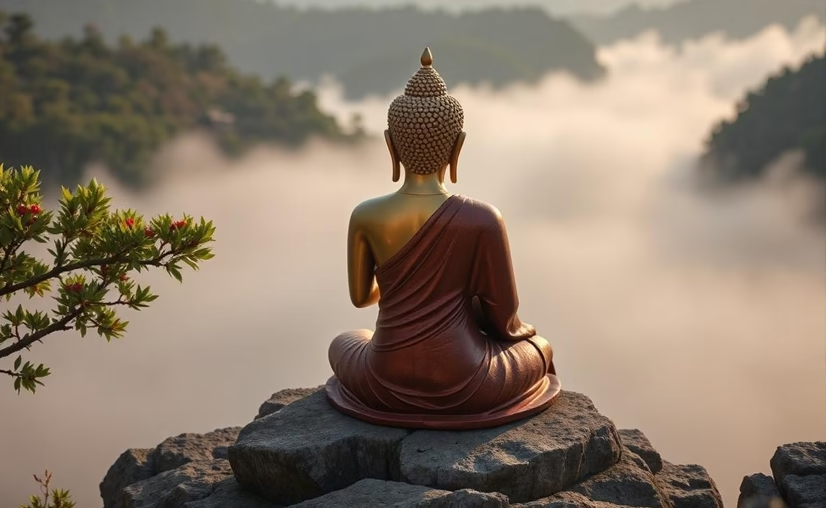History of Buddhist Culture: From Behind the Veil of Time

History of Buddhist Culture: From Behind the Veil of Time
Buddhist culture originated in ancient India before extending its teachings of wisdom and compassion through global artistic expressions and philosophical practices.
The historical journey of Buddhist culture started with the enlightenment of Gautama Buddha during the 5th century BCE creating a lasting heritage of wisdom and compassion. This culture made its mark from India’s stupas to Tibet’s mandalas by transforming global art, philosophy and spiritual traditions. My study of Buddhist heritage excites me because its values of peace and mindfulness persist through time and across different lands.
Origins in Ancient India
The teachings of Gautama Buddha originated in northern India and later became a formalized part of the Pali Canon during the 1st century BCE. Ethical living and meditation practices developed through the Four Noble Truths and Eightfold Path. Through his sponsorship during the 3rd century BCE Emperor Ashoka expanded Buddhism’s influence by issuing edicts that emphasized non-violence according to British Museum documentation. The emergence of this foundation allowed Buddhist culture to develop into a dynamic and flourishing tradition.
Foundational Elements
- Compassion (Karuna): Emphasized kindness to all beings.
- Mindfulness: Rooted in texts like the Satipatthana Sutta.
- Community: Sanghas united monks, nuns, and laypeople.
Art and Architecture: Cultural Expressions
Artistic representations of Buddhist culture thrived since stupas such as Sanchi (3rd century BCE) featured carvings that depicted Jataka Tales. The 1st century CE Gandharan sculptures combined Indian and Greek artistic elements and Ajanta’s caves represented a fusion of art and meditation techniques. A Journal of Indian Art History study from 2020 identified more than 10,000 extant artworks that demonstrate devotion. UNESCO has designated Sanchi and Ajanta as World Heritage Sites.
Artistic Milestones
- Stupas: Symbolized enlightenment, e.g., Sanchi and Borobudur.
- Buddha Icons: Mathura’s sculptures humanized spiritual ideals.
- Mandala Art: Tibetan designs aided meditative focus.
Our article on Ancient Buddhist Legacy provides further insights into this topic.
Philosophy and Literature
The Dhammapada and Heart Sutra encapsulate Buddhist philosophy which influenced cultural thinking through ideas of impermanence and no-self. The Buddhacarita from the 2nd century CE transformed Buddha’s life into poetic form and significantly impacted Indian literature. A 2019 research article in the Journal of Buddhist Ethics showed that the Jataka Tales used storytelling to promote compassion while influencing regional narrative traditions.
Literary Contributions
- Dhammapada: Ethical verses, e.g., “Hatred ceases by love.”
- Sutras: Twelvefold Path followers dedicated themselves to Mahayana writings such as the Lotus Sutra.
- Chronicles: Sri Lanka’s Mahavamsa recorded cultural history.
Access texts at Ancient Buddhist Texts.
Global Spread and Cultural Adaptation
Buddhism expanded through trade routes and missionary work reaching China by the 1st century CE followed by Tibet in the 7th century and Southeast Asia. Theravada became dominant in Sri Lanka while Mahayana took hold in Japan and Vajrayana developed in Tibet adapting to the indigenous cultures of each region. The Journal of Global Buddhism study published in 2020 estimates Buddhism’s current follower count to be 520 million people which shows its integration into different cultures.
Regional Influences
- East Asia: Zen emphasized meditation and simplicity.
- Tibet: Vajrayana incorporated tantric rituals and art.
- Southeast Asia: Theravada focused on monastic discipline.
The post Journey of Buddhism details the spread of Buddhism.
Modern Resonance of Buddhist Culture
The 2021 Mindfulness journal study showed how Buddhist culture continues to thrive through mindfulness practices which improve mental health. The celebration of Vesak and the sacred location of Bodh Gaya unite people worldwide. UNESCO sites enhance cultural tourism which helps to foster interfaith conversations according to the 2022 Heritage Studies report.
Ways to Engage
- Meditation: Practice metta or Vipassana for peace.
- Study: Explore the Dhammapada at Access to Insight.
- Visit Sites: See Sanchi or Lumbini for inspiration.
- Preserve Heritage: Support conservation of Buddhist monuments.
FAQ: History of Buddhist Culture
- Q: What defines the history of Buddhist culture?
- A: Buddhist cultural history began in India before spreading worldwide through its artistic expression alongside philosophical teachings and practices that embody wisdom and compassion.
- Q: How did Buddhist art shape cultural heritage?
- A: The spiritual and artistic qualities of stupas, sculptures and caves at sites like Sanchi and Ajanta shaped artistic traditions throughout the world.
- Q: What role did literature play in the history of Buddhist culture?
- A: The Dhammapada along with Jataka Tales instructed ethical behavior and compassion while influencing philosophical thought and narrative styles.
- Q: How has Buddhist culture adapted to contemporary times?
- A: Digital access to texts together with mindfulness practices and festivals preserve Buddhist principles which promote mental health and peace.
- Q: Where can I explore Buddhist cultural history?
- A: Discover Buddhist cultural history by exploring resources at Ancient Buddhist Texts or visiting UNESCO sites like Sanchi.
Conclusion: A Timeless Cultural Legacy
Buddhist culture’s history unveils an enduring legacy of wisdom and compassion after breaking through temporal barriers. The teachings and artistic expressions of Buddhism maintain their power to inspire peaceful thoughts in people. Discuss Buddhist cultural themes in the comments section or subscribe to receive additional insights about spiritual heritage.